Look at this. Just look at it.
If you’re anything like me, you were in awe when you first saw this watch – just the sheer technical look of it was enough to send my heart racing (and that was even after I’d heard various snippets of description!).
And then the questions come. Why does it look this way? What kind of technology is behind it? Is this really just an instrument to tell the time?
Spoiler alert: answers below.
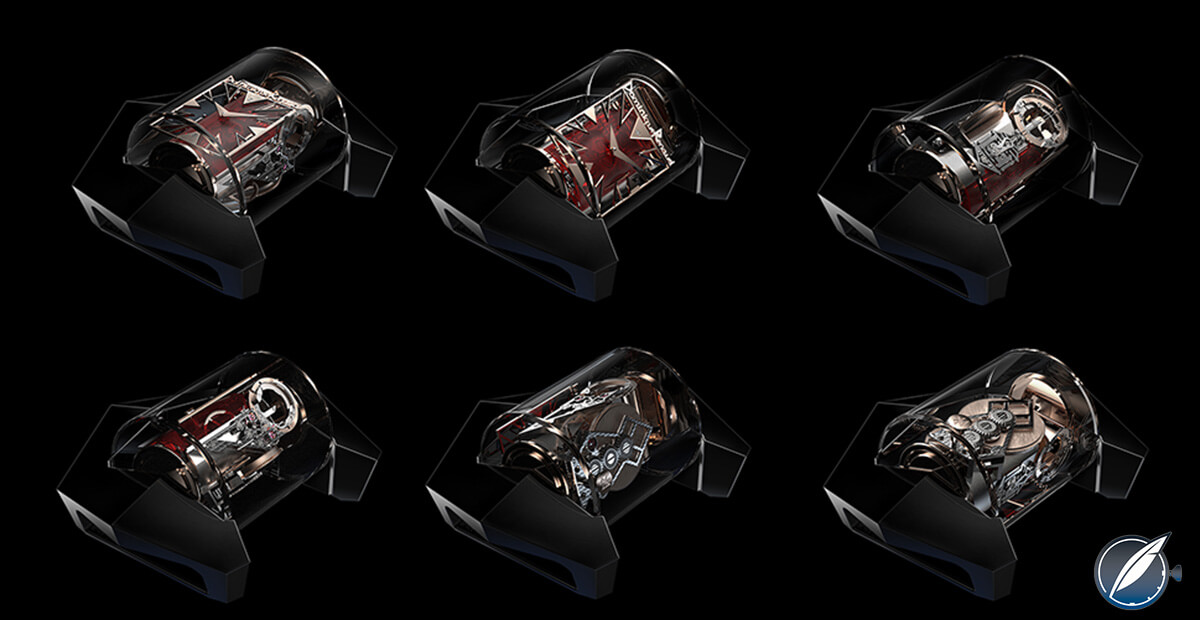
The sapphire crystal ‘visio module’ offers 360° views of the dial and movement of Dominique Renaud’s DR01 Twelve First
The thought process
A previous article, Dominique Renaud: A Horological Grand Master Then And Now, explored Renaud’s vast experience in creating new and important horological concepts in watchmaking. These helped usher in a new era of superwatches that not only looked different, but had at their cores improved chronometry and completely new functionality.
Summing the article up: Renaud’s past indubitably shows that he is capable of thinking outside the box. And not just a little outside the box, but way out of sight.
But then he needed a break. Fifteen years away from the intense world of high-end watches allowed his thoughts to wander deeper into the whys and wherefores of the world of miniature mechanical marvels.
And, for a first solo project, what he has come up with as a “comeback” sort of breaks the bank; it goes beyond anything he – or anyone else for that matter – has done before in terms of both mechanics and design, especially someone so rooted in classical horology.
He calls this first project – created within a company he has named after himself, “Dominique Renaud SA” – a “distilled essence of his inspiration, creative energy, and technical explorations over the last decade and a half.”
And as we all know, when you free your mind, the rest will follow. So get ready.
The watch idea
Let’s just get this out of the way first: Renaud is not interested in becoming a watch manufacturer or a brand in the conventional sense.
His interest is in doing what he’s always done: to create completely new paths of thought and new ways of improving technology. But it’s also important to remember that while some of the technology in DR01 Twelve First, which is the name of this watch, has never been seen before in a technical sense, it fully and completely adheres to the ideals of haute horlogerie.
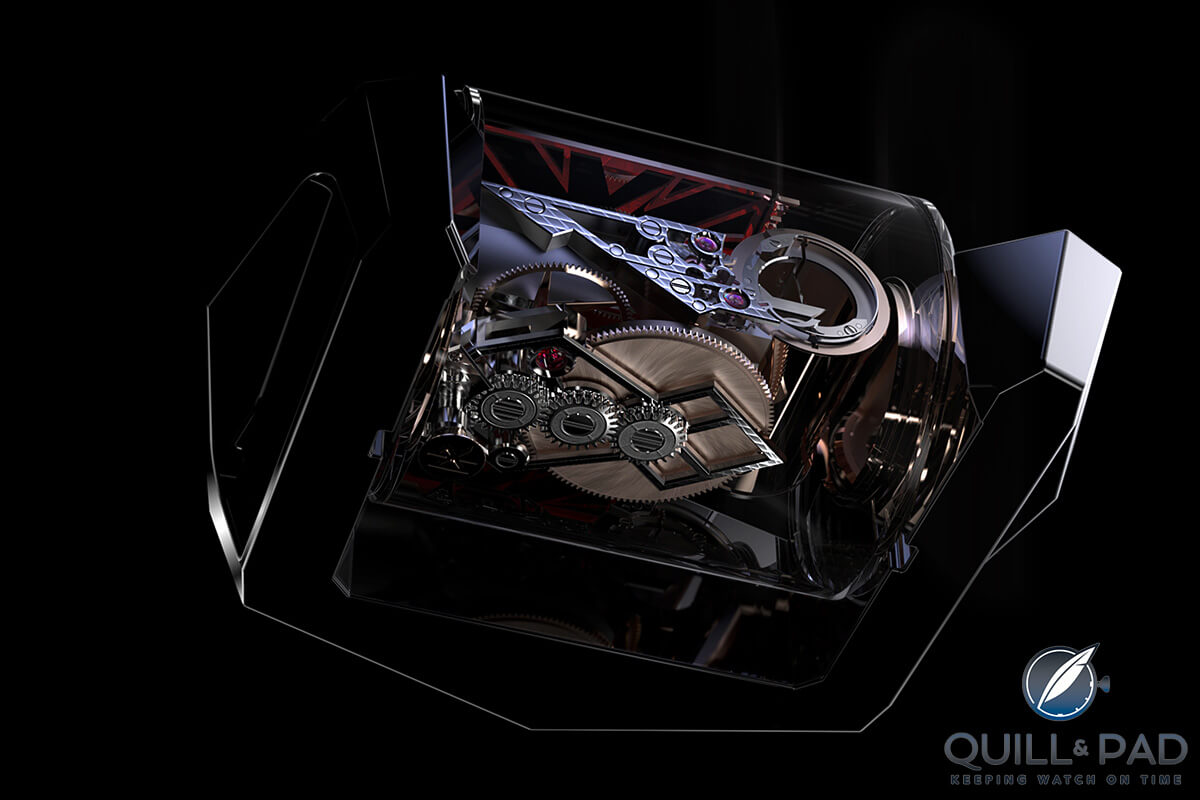
A view of the back of the Dominique Renaud DR01 Twelve First through the sapphire crystal ‘visio module’ offering 360° views of the dial and movement
Renaud’s vision is to involve 12 serious collectors in the process of this watch’s prototyping phase, which should last into 2017.
“The concept for my ‘brand’ is to reach the ideal version,” Renaud confirms. “These 12 versions will be sold to the passionate collectors who participate in the adventure with us.”
The collectors could be seen as ambassadors of sorts who embark upon this special journey with Renaud. Not only are they participating in enabling the project to reach its full potential, they come away with a watch that is unique and that can be customized to his or her own specifications.
If you’re thinking this sounds a bit like the vintage practice of souscription, you are right. It’s anticipated that the first watches will be delivered in 2017.
Looks are everything, but . . .
The DR01 Twelve First by Dominique Renaud looks like nothing you have ever seen.
The core is a tube of sapphire crystal containing the movement and dial. At the moment, it shows only the hours and minutes using hands.
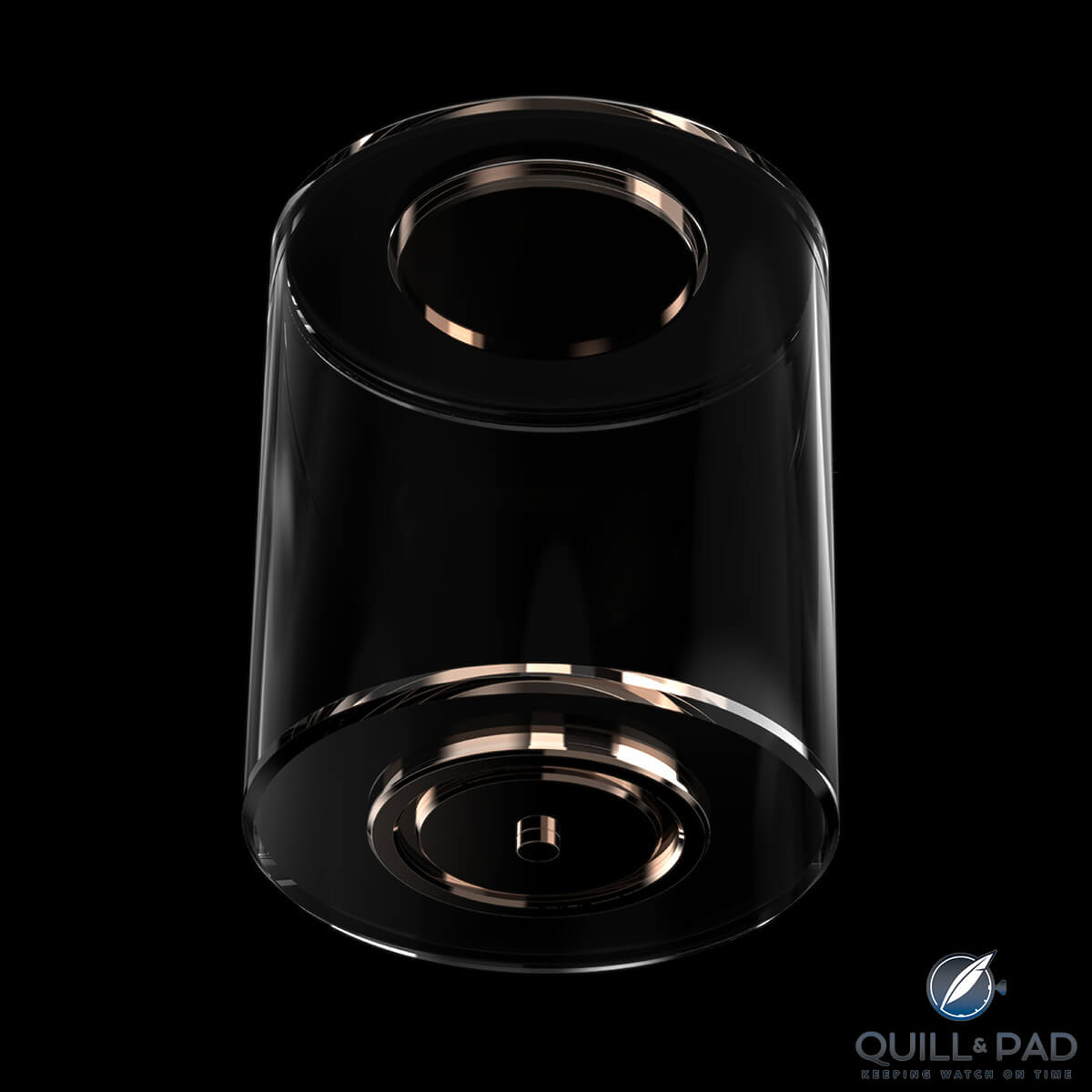
The sapphire crystal ‘visio module’ offers 360° views of the dial and movement of Dominique Renaud’s DR01 Twelve First
The sapphire crystal tube (which Renaud calls a “capsule” or “visio module”) is attached to its strap by a metal bracket (which he calls an “arch”) that holds it in place while still allowing 360-degree visibility of what is inside. What we find inside is an array of cylindrical elements (more below).
We see that angularity is emphasized in the entire design. This angularity is derived from both Renaud’s initials in his stylized logo and from the concept of the very finely finished internal angles found in the very best movements, which is evidence of very high-quality hand-finishing.
As each individual piece of the DR01 Twelve First is fully customizable, the choice of material used to make the arch carved from a single block of material is left up to the owner, as is the choice of dial material and color.
New blade resonator
The DR01 by Dominique Renaud includes three main new technologies: a blade resonator, an experimental rotary escapement, and a multiform spring – all elements of the regulating and oscillating systems.
In other words, they concern the very heart of the mechanical watch, that which is responsible for ensuring that the movement is as precise and reliable as it can be.
And let’s get this out of the way as well: as it stands now, the DR01 movement contains no silicon components, but it does include LIGA-grown nickel-phosphorus elements by Mimotec, which were needed for their specific geometry.
Basically, the biggest motivation for inventing a new regulating system was to remove its weakest link, which is the balance staff. The balance staff is a pivot (basically an axle) holding the balance assembly in place, but it can be rather fragile, in particular when the watch is subjected to shock.
Watch the video above: it starts off with a visualization of a conventional balance, after which it shows you the blade resonator that replaces it in the DR01.
Today’s balance staffs have a diameter of around one-tenth of a millimeter and are usually protected by shock resistance elements like Incabloc and Kif.
So to eliminate the weak-link balance staff, Renaud has replaced it with a virtual pivot he calls the blade resonator. To understand it, imagine a long, cylindrical pivot cut into three parts and distributed along the same plane. These revolve virtually around the same virtual axis. Each of the segments acts independently, forming a “free” balance that Renaud calls a “spatial pivot.”
The blade shaped, semi-cylindrical fragments perform their “revolutions” within ruby bearings – like a conventional balance. But these ruby spheres are notched with a V-shaped slit so they act more like ball-and-socket joints than pivot-and-jewel subgroups. And they are perfectly self-positioning.
And, as Joshua pointed out in his extra-nerdy article The Parmigiani Senfine Concept Features Grasshoppers And Silicon, when there is no pivot staff, the friction inherent to a balance assembly completely disappears.
“That is one of the major points of energy loss in an escapement system, and here it has been completely eliminated,” Joshua said with regard to the Parmigiani Senfine concept, which also utilizes the idea of a virtual pivot, but needs silicon to get there.
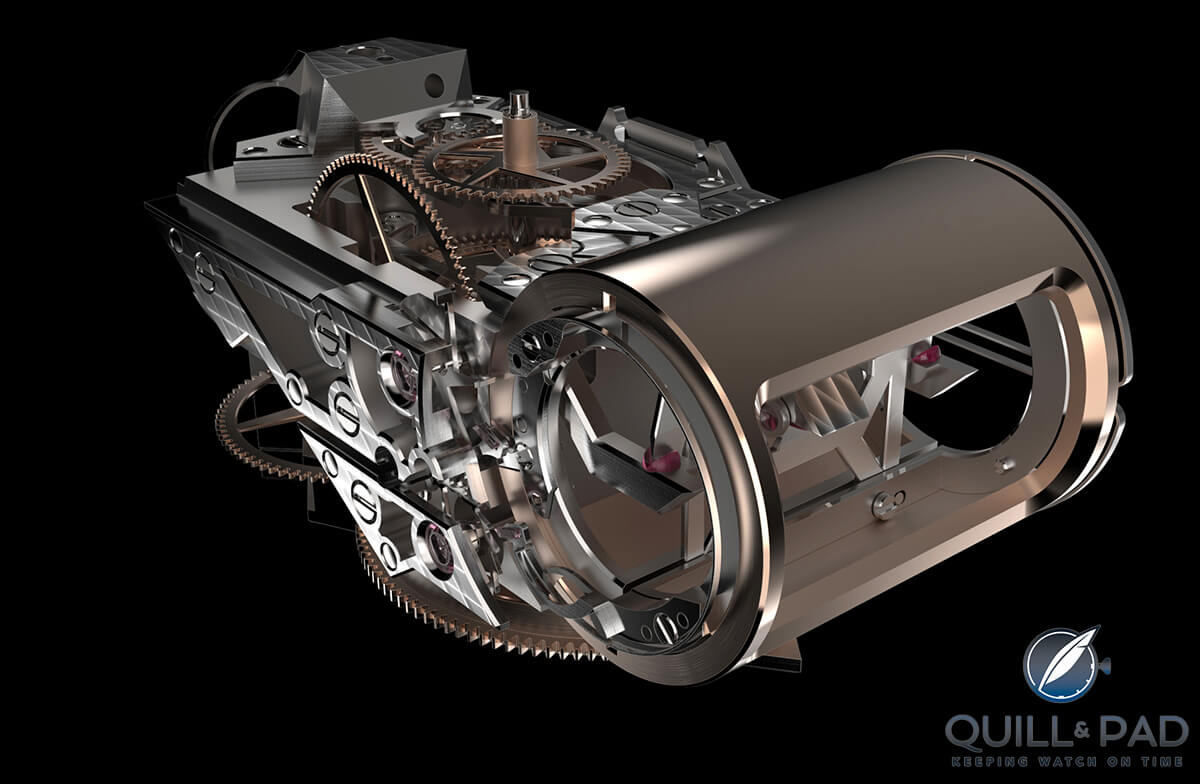
The movement of Dominique Renaud’s DR01 Twelve First with the large blade resonator in the foreground
The most important thing is that this arrangement can support weight – which it can because the new pivot, being virtual, is unbreakable.
Spring or no spring
Renaud has set up his regulating system to accommodate a number of spring shapes, a system he calls the “multiform spring.” The minimal amplitude of the regulator leaves the question of the spring shape open. In the DR01 Twelve First, he has chosen to use an original crossbow-shaped resonator spring.
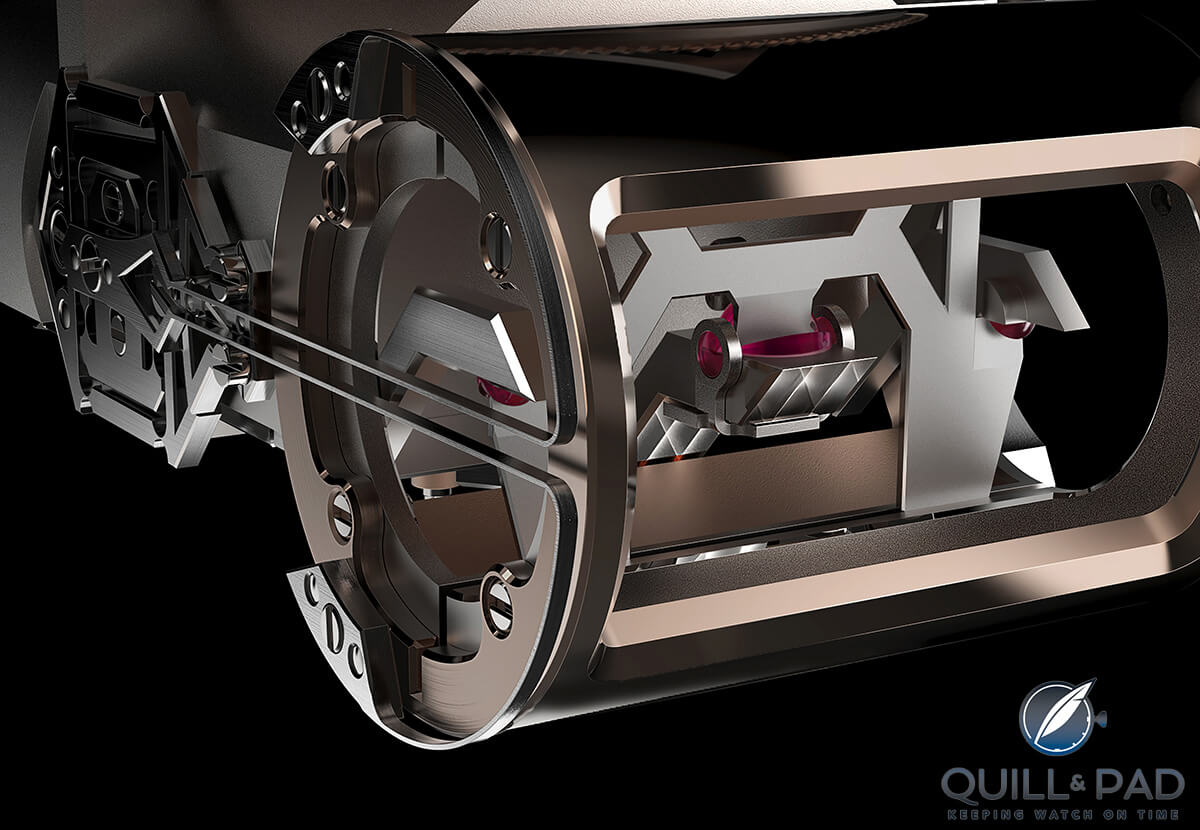
The balance assembly: what you see on the left is what passes for the balance spring in the DR01 Twelve First by Dominique Renaud
I’ll refer back to Joshua’s Senfine article again regarding this, where Parmigiani uses a silicon component in place of a balance spring.
“However, all new forms and all spring lengths can be used in order to find the right setup for perfect isochronism,” Renaud assured me. “We can test several frequencies since the escapement is adaptable.”
The current timing fine adjustment system used in the prototype phase is an XY table collar guide system, which changes the spring’s effective length (like in a conventional system) and centers the resonator spring.
Then Renaud added a small, but heavy, flywheel to the mix (see above). This reduces the lift angle, which in turn allows the subgroup to work with much smaller amplitudes.
In fact, the DR01’s blade resonator exhibits amplitude of just 30 degrees (by comparison, a conventional balance wheel’s amplitude should be in the 220-to-300-degree range).
Additionally, the size of this oscillator is interesting. In the DR01 Twelve First, the size was chosen to allow maximum highlighting of its existence and a detailed scrutiny of the components through the sapphire crystal. Renaud’s studies have shown, however, that it can be miniaturized further to produce a much smaller movement.
The experimental rotary escapement
Renaud views this as an experimental laboratory escapement because he fully intends to continue developing it according to the findings of the First Twelve prototypes. However, the basic principles are very likely to stay the same.
Renaud has thought up a system that drops impulses. Naming it a “free rotary lost beat détente escapement with direct impulse,” his goal was to minimize disruption to the system, thereby improving chronometry.
The specifics are certain to change and develop as prototype performances are registered, but currently the system comprises one impulse to nine lost – meaning only one in ten impulses are actually completed. The frequency currently set is 5 Hz/36,000 vph.
“Some watches exist with two or three lost beats,” Renaud explains. “But the idea here is to have much more than that. We made first tests with 10 to 12 lost beats to avoid perturbing the isochronism of the balance wheel with impulses. All the ingredients are present: superior quality and small amplitude. This will help in particular when increasing frequency and reducing the number of impulses; this purely mechanical construction has all the necessary features for good chronometry.”
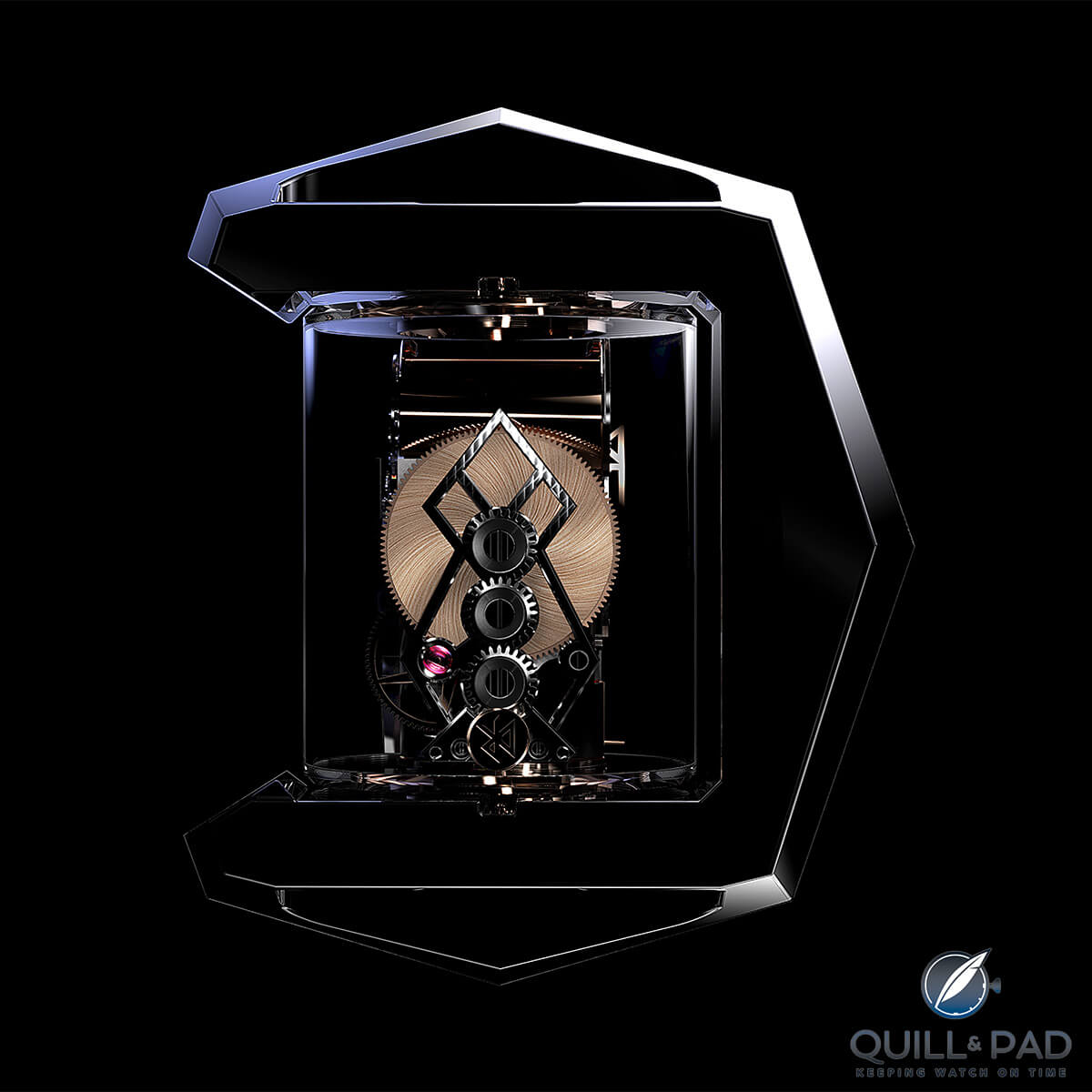
The mainspring barrel cover stands out as a backdrop to the in-line gear train in this back of the movement of Dominique Renaud’s DR01 Twelve First
Interestingly, thanks to the gear train ratio that Renaud calculated, the period of time between each impulse completed turns out to be exactly one second. It is also interesting to note that the gear train is in-line, which allows for more efficient transfer of energy.
If that part looks familiar, it should. The concept was used in HYT’s H3, which launched in March 2015 – and was also conceived by Renaud (see How The H3 Is Set To Ensure HYT’s Future).
Taking all of this into account, Renaud believes that one spring barrel should be able to supply two weeks’ worth of power to his DR01. But there’s one thing that is his main focus in all of this: “My main idea was to reduce friction and increase the quality.”
A natural complication
Though this watch currently displays only the hours and minutes by use of hands, if you look closely at the top of the movement through the transparent dial, you will quite plainly see the fourth wheel, which in any normal watch would drive the second hand.
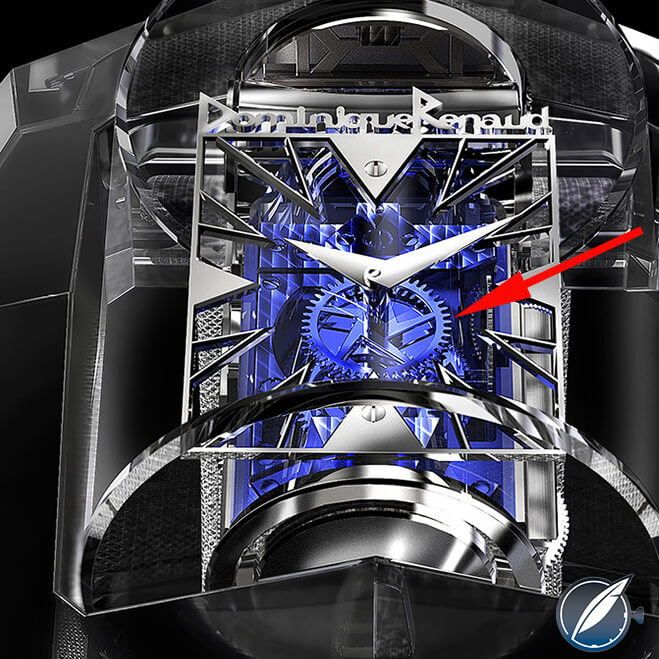
You can clearly see the large fourth wheel of the Dominique Renaud DR01 Twelve First that usually drives the second hand
It also displays the seconds here, but unobtrusively without a dedicated hand, using only a graduated scale marked on the wheel.
This is part of the customization left to the owner – hand or no hand.
The price of admission for prospective collectors is about $1 million, so unfortunately the DR01 will be for the well-heeled only.
Maybe you’ve gotten it by now: Renaud’s ultimate goal is to create the perfect movement. Therefore, we can view the 12 examples of the DR01 that are set to emerge next year as little laboratories. “I want to provide a new impulse to the industry,” he explained. “My wish is to show what full, no-limits freedom can do.”

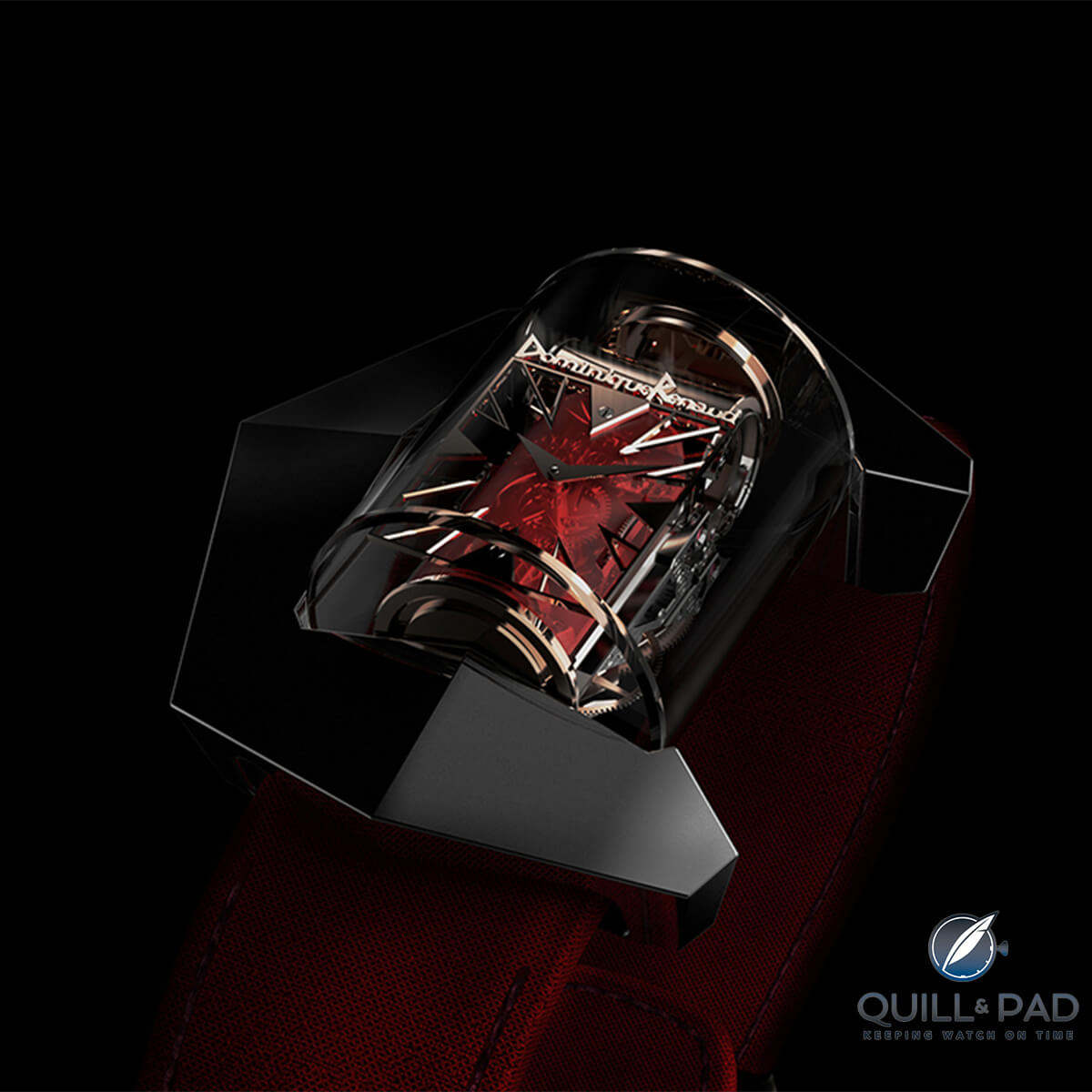
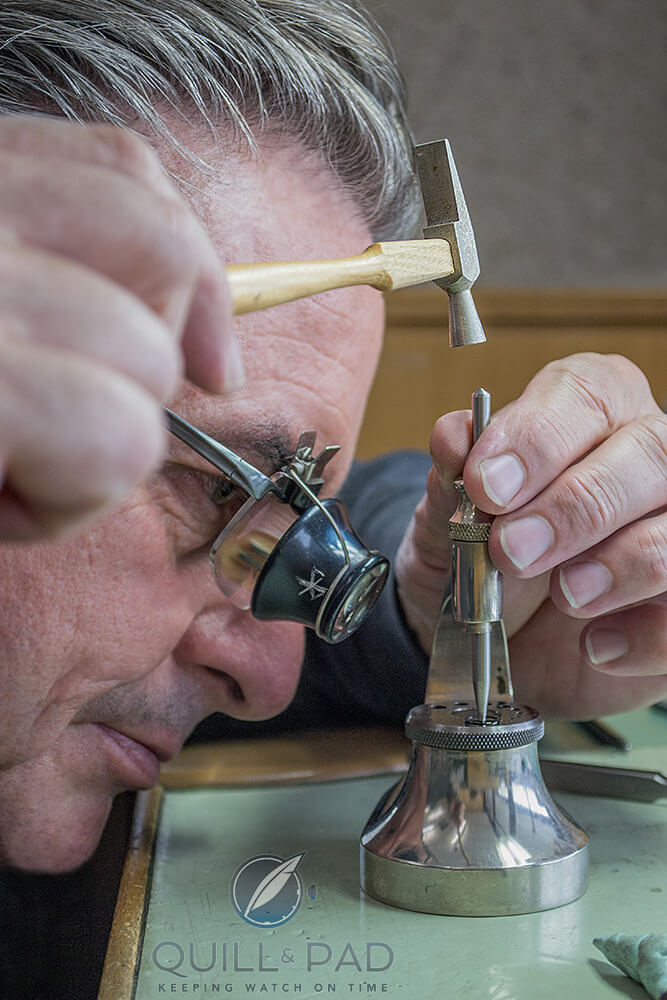
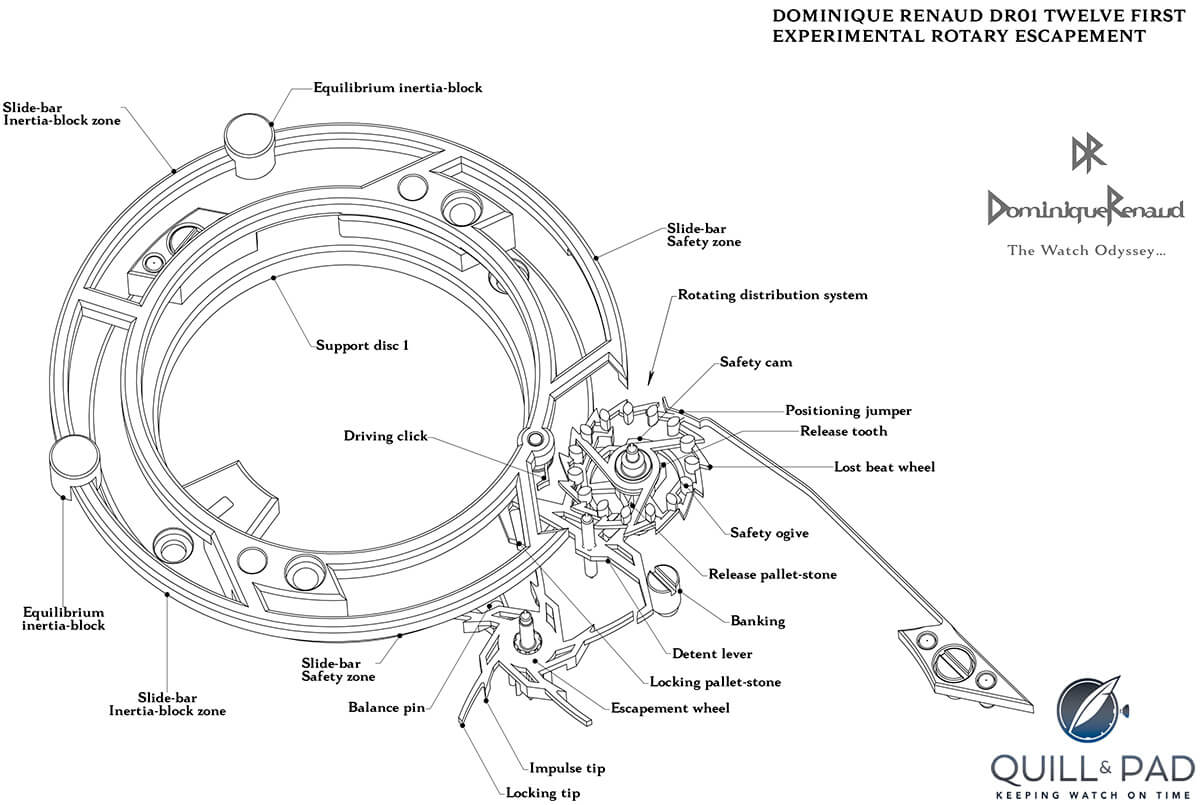
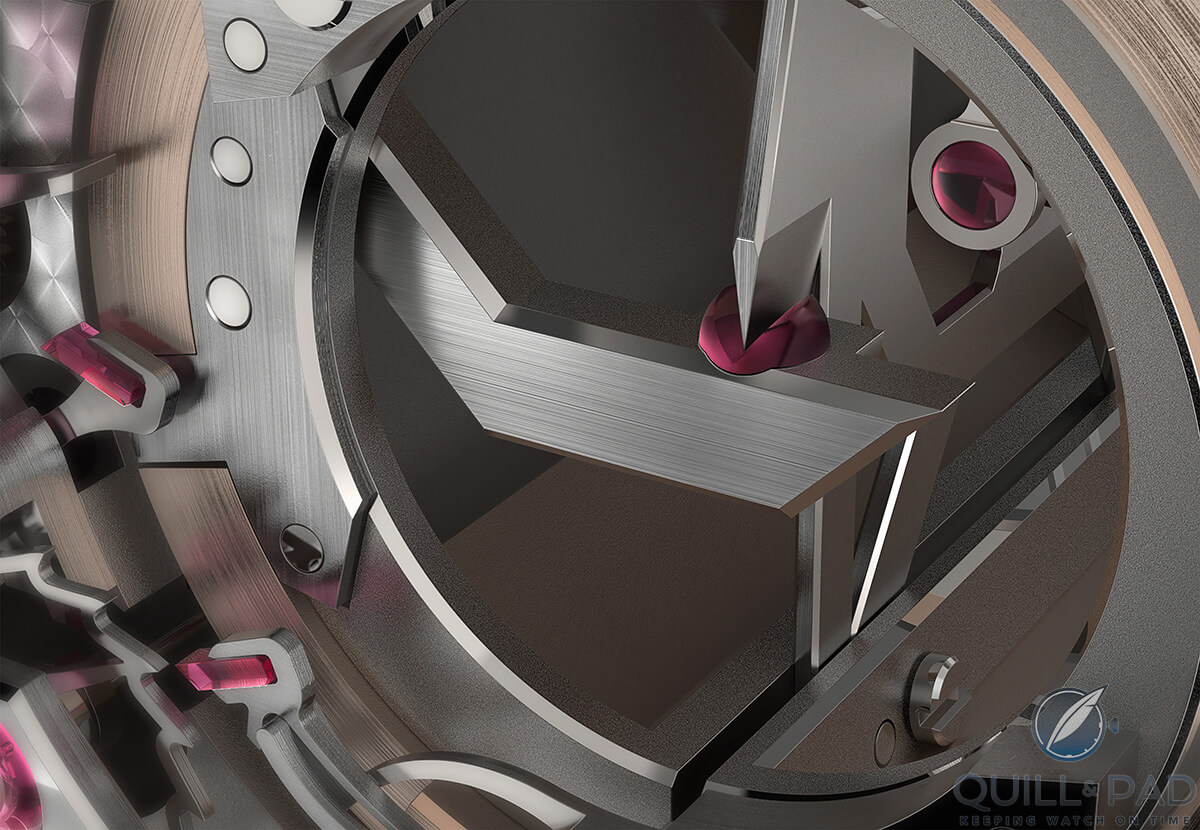
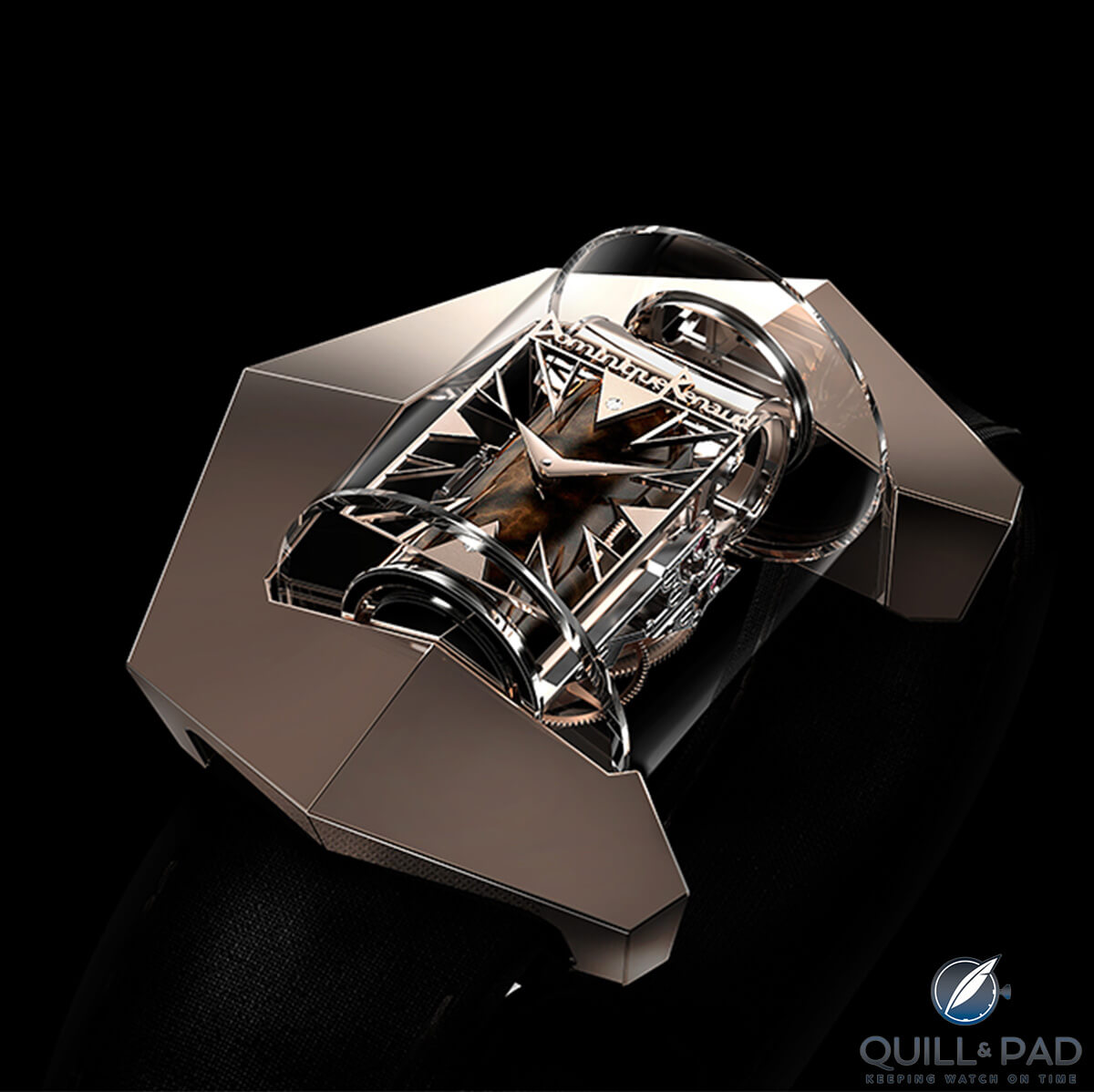
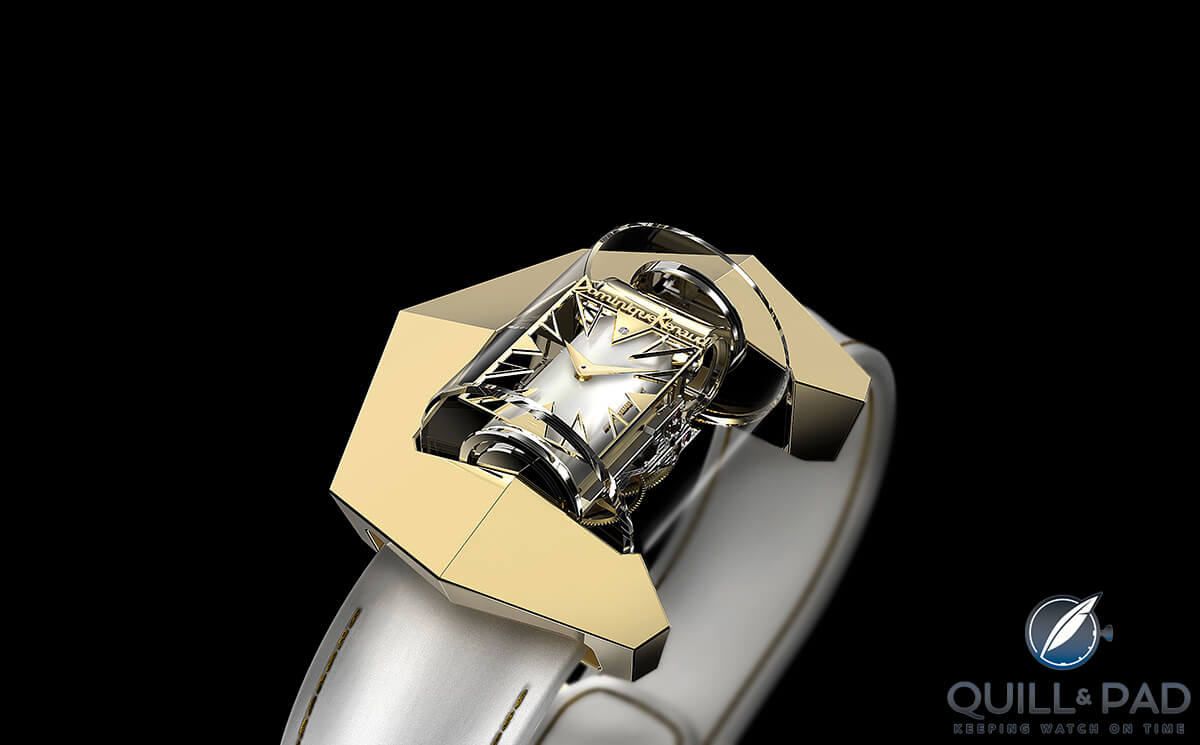
Trackbacks & Pingbacks
[…] Time for a monumentally large finish: the only watch in existence branded Renaud & Papi, this openworked perpetual calendar pocket watch is the personal property of Dominique Renaud, who was kind enough to share with Elizabeth and I during a lunch otherwise devoted to discussing his new project (see Dominique Renaud: A Horological Grand Master Then And Now and Dominique Renaud’s DR01 ‘Twelve First’ With Blade Resonator, Experimental Rotary Escapement, A…). […]
[…] My money-no-object watch would be the Dominique Renaud DR01 (see Dominique Renaud’s DR01 ‘Twelve First’ With Blade Resonator, Experimental Rotary Escapement, A…), even though it hasn’t materialized just yet. I do believe it’s more than doable, […]
Leave a Reply
Want to join the discussion?Feel free to contribute!